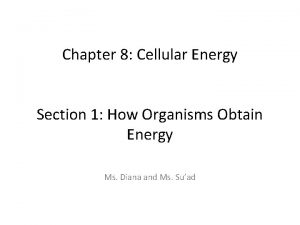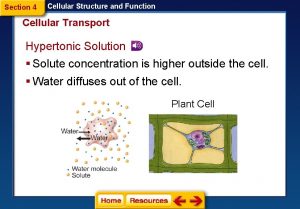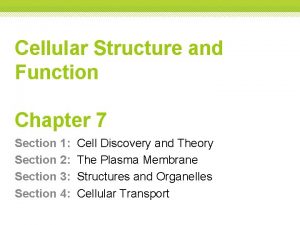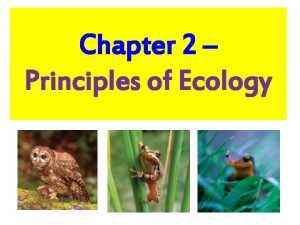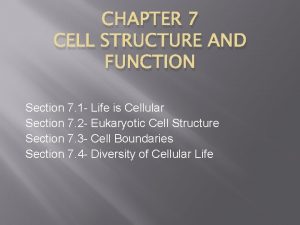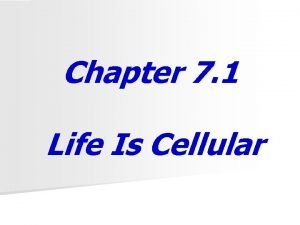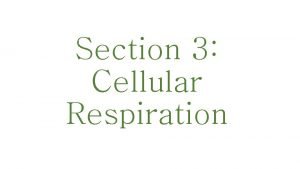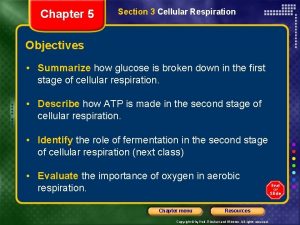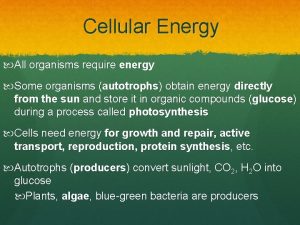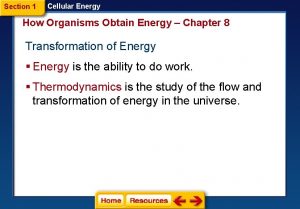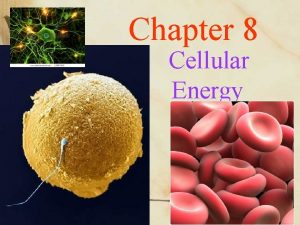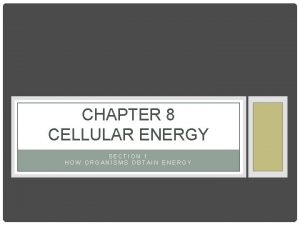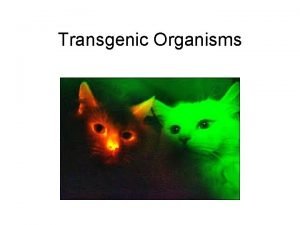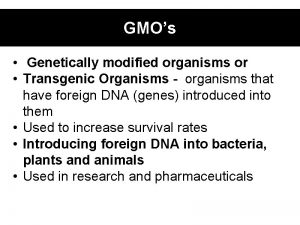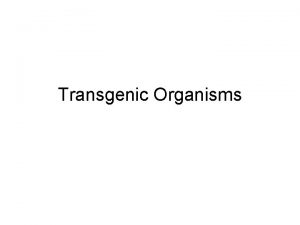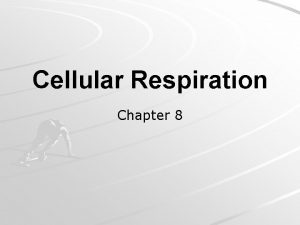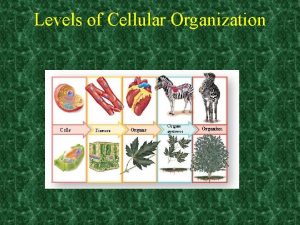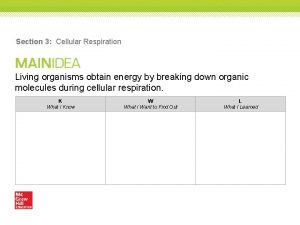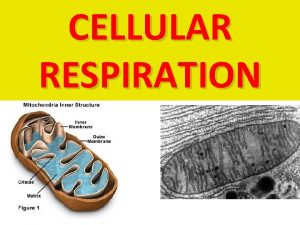Chapter 8 Cellular Energy Section 1 How Organisms

























- Slides: 25

Chapter 8 Cellular Energy Section 1: How Organisms Obtain Energy Section 2: Photosynthesis Section 3: Cellular Respiration Click on a lesson name to select.

Chapter 8 Cellular Energy 8. 1 How Organisms Obtain Energy Transformation of Energy § Energy is the ability to do work. § Thermodynamics is the study of the flow and transformation of energy in the universe.

Chapter 8 Cellular Energy 8. 1 How Organisms Obtain Energy Laws of Thermodynamics § First law—energy can be converted from one form to another, but it cannot be created nor destroyed. § Second law—energy cannot be converted without the loss of usable energy.

Chapter 8 Cellular Energy 8. 1 How Organisms Obtain Energy Autotrophs and Heterotrophs § Autotrophs are organisms that make their own food. § Heterotrophs are organisms that need to ingest food to obtain energy.

Chapter 8 Cellular Energy 8. 1 How Organisms Obtain Energy Metabolism § All of the chemical reactions in a cell § Photosynthesis—light energy from the Sun is converted to chemical energy for use by the cell § Cellular respiration—organic molecules are broken down to release energy for use by the cell

Chapter 8 Cellular Energy 8. 1 How Organisms Obtain Energy ATP: The Unit of Cellular Energy § ATP releases energy when the bond between the second and third phosphate groups is broken, forming a molecule called adenosine diphosphate (ADP) and a free phosphate group. ATP

Chapter 8 Cellular Energy 8. 2 Photosynthesis Overview of Photosynthesis § Photosynthesis occurs in two phases. § Light-dependent reactions § Light-independent reactions

Chapter 8 Cellular Energy 8. 2 Photosynthesis Phase One: Light Reactions § The absorption of light is the first step in photosynthesis. § Chloroplasts capture light energy.

Chapter 8 Cellular Energy 8. 2 Photosynthesis Electron Transport § Light energy excites electrons in photosystem II and also causes a water molecule to split, releasing an electron into the electron transport system, H+ into the thylakoid space, and O 2 as a waste product.

Chapter 8 Cellular Energy 8. 2 Photosynthesis § The excited electrons move from photosystem II to an electron-acceptor molecule in the thylakoid membrane. § The electron-acceptor molecule transfers the electrons along a series of electron-carriers to photosystem I.

Chapter 8 Cellular Energy 8. 2 Photosynthesis § Photosystem I transfers the electrons to a protein called ferrodoxin. § Ferrodoxin transfers the electrons to the electron carrier NADP+, forming the energystoring molecule NADPH.

Chapter 8 Cellular Energy

Chapter 8 Cellular Energy 8. 2 Photosynthesis Phase Two: The Calvin Cycle § In the second phase of photosynthesis, called the Calvin cycle, energy is stored in organic molecules such as glucose.

Chapter 8 Cellular Energy

Chapter 8 Cellular Energy 8. 2 Photosynthesis § Six CO 2 molecules combine with six 5 -carbon compounds to form twelve 3 -carbon molecules called 3 -PGA. § The chemical energy stored in ATP and NADPH is transferred to the 3 -PGA molecules to form high-energy molecules called G 3 P.

Chapter 8 Cellular Energy 8. 2 Photosynthesis § Two G 3 P molecules leave the cycle to be used for the production of glucose and other organic compounds. § An enzyme called rubisco converts the remaining ten G 3 P molecules into 5 -carbon molecules called Ru. BP. § These molecules combine with new carbon dioxide molecules to continue the cycle.

Chapter 8 Cellular Energy 8. 2 Photosynthesis Alternative Pathways § C 4 plants § CAM plants

Chapter 8 Cellular Energy 8. 3 Cellular Respiration Overview of Cellular Respiration § Organisms obtain energy in a process called cellular respiration. § The equation for cellular respiration is the opposite of the equation for photosynthesis.

Chapter 8 Cellular Energy 8. 3 Cellular Respiration § Cellular respiration occurs in two main parts. § Glycolysis § Aerobic respiration

Chapter 8 Cellular Energy 8. 3 Cellular Respiration Glycolysis § Glucose is broken down in the cytoplasm through the process of glycolysis. § Two molecules of ATP and two molecules of NADH are formed for each molecule of glucose that is broken down.

Chapter 8 Cellular Energy 8. 3 Cellular Respiration Krebs Cycle § Glycolysis has a net result of two ATP and two pyruvate. § Most of the energy from the glucose is still contained in the pyruvate. § The series of reactions in which pyruvate is broken down into carbon dioxide is called the Krebs cycle.

Chapter 8 Cellular Energy 8. 3 Cellular Respiration § The net yield from the Krebs cycle is six CO 2 molecules, two ATP, eight NADH, and two FADH 2.

Chapter 8 Cellular Energy

Chapter 8 Cellular Energy 8. 3 Cellular Respiration Electron Transport § Final step in the breakdown of glucose § Point at which ATP is produced § Produces 24 ATP

Chapter 8 Cellular Energy 8. 3 Cellular Respiration Anaerobic Respiration § The anaerobic pathway that follows glycolysis § Two main types § Lactic acid fermentation § Alcohol fermentation Cellular Respiration
 Cellular energy section 1 how organisms obtain energy
Cellular energy section 1 how organisms obtain energy Chapter 8 section 1 how organisms obtain energy answer key
Chapter 8 section 1 how organisms obtain energy answer key Chapter 8 section 1 how organisms obtain energy
Chapter 8 section 1 how organisms obtain energy Chapter 8 section 1 how organisms obtain energy
Chapter 8 section 1 how organisms obtain energy Chapter 8 section 2 photosynthesis
Chapter 8 section 2 photosynthesis Member of the same species
Member of the same species Unicellular and multicellular
Unicellular and multicellular Chapter 8 section 3 cellular respiration continued
Chapter 8 section 3 cellular respiration continued Chapter 9 section 1 cellular growth
Chapter 9 section 1 cellular growth Section 4 cellular transport
Section 4 cellular transport Section 1 cellular growth
Section 1 cellular growth Chapter 7 section 1 cell discovery and theory
Chapter 7 section 1 cell discovery and theory Cellular respiration harvesting chemical energy
Cellular respiration harvesting chemical energy Explain how amp stimulates cellular respiration
Explain how amp stimulates cellular respiration Chapter 9: cellular respiration: harvesting chemical energy
Chapter 9: cellular respiration: harvesting chemical energy Principles of ecology section 3 cycling of matter
Principles of ecology section 3 cycling of matter Chapter 2 section 1 organisms and their relationships
Chapter 2 section 1 organisms and their relationships Chapter 2 principles of ecology answer key
Chapter 2 principles of ecology answer key Chapter 2 principles of ecology answer key
Chapter 2 principles of ecology answer key Chapter 2 section 1 organisms and their relationships
Chapter 2 section 1 organisms and their relationships Section 2 describing energy worksheet answers
Section 2 describing energy worksheet answers Section 7-1 life is cellular
Section 7-1 life is cellular Section 7-1 life is cellular answer key
Section 7-1 life is cellular answer key What's cellular respiration
What's cellular respiration Section 4 cellular transport answer key
Section 4 cellular transport answer key Section 3 cellular respiration worksheet answers
Section 3 cellular respiration worksheet answers


